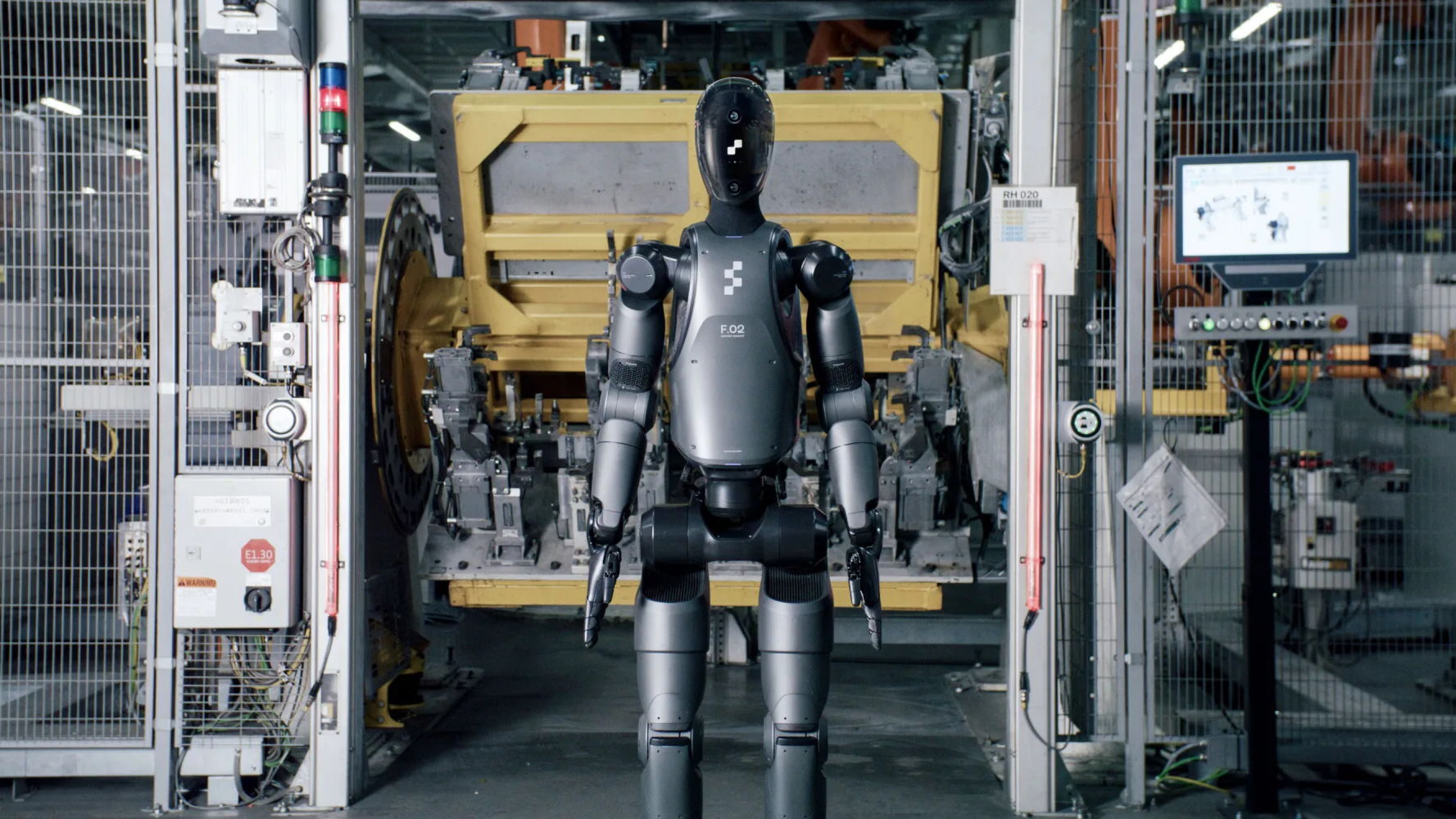Humanoid Robots: UPS And Figure AI Collaboration

Table of Contents
Figure AI's Humanoid Robot Technology
### Advanced Capabilities of Figure 01
Figure AI's flagship humanoid robot, Figure 01, represents a significant leap forward in robotics technology. Its advanced capabilities are poised to revolutionize numerous sectors, including logistics. This impressive machine boasts:
- Dexterous Manipulation: Figure 01 possesses incredibly dexterous hands, capable of picking, placing, and manipulating a wide variety of objects with precision. This is crucial for tasks like package sorting and handling fragile items.
- Autonomous Navigation: Equipped with sophisticated AI-powered navigation systems, Figure 01 can move freely and safely within complex environments like warehouses, adapting to obstacles and changing conditions.
- AI-Powered Intelligence: The robot utilizes advanced machine learning algorithms to learn from its experiences, constantly improving its performance and efficiency. This allows it to adapt to new tasks and optimize its operations over time.
- Object Recognition & Grasp Planning: Figure 01 can identify and classify different objects, selecting the most appropriate grasp for each item to ensure efficient and safe handling.
Figure 01's unique advantage lies in its combination of dexterity, intelligence, and mobility, surpassing the capabilities of many existing robotic solutions. Its advanced AI-powered systems enable seamless integration into existing warehouse management systems.
### Scalability and Production Readiness
Figure AI is committed to scaling production of Figure 01 to meet the growing demand for humanoid robots across various industries. This scalability is critical for widespread adoption and cost-effectiveness. Their plans include:
- Phased Production Ramp-up: Figure AI is employing a strategic, phased approach to manufacturing, ensuring quality control and efficient scaling.
- Strategic Partnerships: Collaborations with component suppliers and manufacturing partners are crucial for meeting the demands of mass production.
- Cost Optimization: Figure AI is continuously working on optimizing the manufacturing process to reduce costs and make humanoid robots more accessible.
The successful mass production of humanoid robots like Figure 01 signifies a major shift in automation technology, making advanced robotics solutions accessible to a broader range of businesses.
UPS's Integration Strategy for Humanoid Robots
### Addressing Current Logistics Challenges
UPS faces numerous challenges in its daily operations, including labor shortages, increasing package volumes, and the need for greater efficiency. Humanoid robots offer a powerful solution to these issues by:
- Automating Repetitive Tasks: Robots can handle repetitive tasks like package sorting, loading, and unloading, freeing up human workers for more complex and strategic roles.
- Improving Warehouse Efficiency: Optimizing warehouse workflows through automation leads to faster processing times and reduced operational costs.
- Enhancing Last-Mile Delivery: While still in its early stages, the potential for humanoid robots in last-mile delivery is significant, especially for tasks requiring interaction with customers or navigating complex delivery environments.
- Supply Chain Optimization: Integration of humanoid robots into the supply chain can lead to improved tracking, faster delivery times, and enhanced overall efficiency.
The use of humanoid robots promises to significantly improve package handling and optimize e-commerce logistics for UPS.
### Pilot Programs and Future Deployment
UPS is strategically deploying Figure AI's robots through a phased approach. This includes:
- Pilot Programs in Select Warehouses: Initial pilot programs are focused on testing the robots in controlled environments to evaluate their performance and gather crucial data.
- Data Analysis and Optimization: UPS is leveraging data analytics to continuously refine the robots' performance and integrate them seamlessly into existing workflows.
- Gradual Expansion: Based on the success of pilot programs, UPS plans to gradually expand the deployment of humanoid robots to more warehouses and potentially to other areas of its operations.
The integration strategy emphasizes a careful and measured approach, ensuring a smooth transition and minimizing disruption.
Societal and Economic Implications
### Job Displacement Concerns and Workforce Reskilling
The integration of humanoid robots into the workforce inevitably raises concerns about job displacement. However, this is an opportunity for workforce transformation:
- Retraining and Upskilling Initiatives: UPS and other companies can invest in retraining programs to equip workers with skills relevant to the changing job market, focusing on robot maintenance, programming, and management.
- Creation of New Roles: The widespread adoption of humanoid robots will also create new job roles related to robot maintenance, programming, and oversight. These roles will require specialized skills and expertise.
Addressing these concerns proactively is crucial for a smooth transition and ensuring a positive impact on the workforce.
### The Future of Work with Humanoid Robots
The long-term impact of humanoid robots on the workplace will likely involve increased human-robot collaboration:
- Collaborative Work Environments: Humans and robots will work side-by-side, leveraging each other's strengths to maximize productivity and efficiency.
- Enhanced Safety and Productivity: Robots can handle dangerous or physically demanding tasks, improving worker safety and overall productivity.
- Focus on Higher-Level Tasks: Human workers can focus on more complex and strategic tasks, utilizing their creativity and problem-solving abilities.
The future of work will likely be characterized by a synergistic relationship between humans and humanoid robots, driving innovation and productivity.
The Transformative Potential of Humanoid Robots in Logistics
The partnership between UPS and Figure AI represents a significant step towards revolutionizing the logistics industry. The integration of humanoid robots promises significant improvements in efficiency, cost reduction, and workforce adaptation. The potential benefits extend beyond logistics, impacting various sectors and reshaping the future of work. Learn more about how humanoid robots are transforming the logistics industry and discover the latest advancements in automation technology.

Featured Posts
-
 Ubisoft Entertainment Decryptage Du Document Amf Cp 2025 E1029768
Apr 30, 2025
Ubisoft Entertainment Decryptage Du Document Amf Cp 2025 E1029768
Apr 30, 2025 -
 Deadly Afterschool Car Crash Video Footage Emerges
Apr 30, 2025
Deadly Afterschool Car Crash Video Footage Emerges
Apr 30, 2025 -
 Manchester Eurovision A Comprehensive Guide For Fans
Apr 30, 2025
Manchester Eurovision A Comprehensive Guide For Fans
Apr 30, 2025 -
 Superboul 2025 Vystupleniya Skandaly I Neozhidannye Momenty
Apr 30, 2025
Superboul 2025 Vystupleniya Skandaly I Neozhidannye Momenty
Apr 30, 2025 -
 Zustrich Trampa Ta Zelenskogo Rozkrito Prichinu Yikhnogo Okremogo Sidinnya
Apr 30, 2025
Zustrich Trampa Ta Zelenskogo Rozkrito Prichinu Yikhnogo Okremogo Sidinnya
Apr 30, 2025
